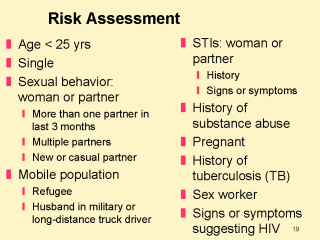 |
Risk
assessment is important for two reasons. In countries where there is a low HIV prevalence,
risk assessment helps determine who is most appropriate to target for counseling and
testing. It is also important on an individual basis to identify specific risky behaviors
in order to provide effective risk reduction counseling. The factors listed here help
identify individuals who may be at increased risk for HIV infection. Young single men and
women are likely to be at increased risk because of greater frequency of unprotected
sexual activity and increased likelihood of multiple partners. Young women may also be
more vulnerable to HIV for physiologic reasons, such as increased rates of cervical
ectopy. Studies have demonstrated that women whose husbands are long-distance truck
drivers or are in the military are at increased risk because their husbands are more
likely to have had contact with commercial sex workers. Similarly, when a population is
unstable because or war or famine, families may be separated and unsafe sexual practices
are more common. Certain specific sexual behaviors, signs or symptoms or history of a
sexually transmitted infection in the woman or her partner, and a current or past history
of injection or noninjection drug or alcohol abuse indicate individuals at increased risk
of HIV who should receive individualized counseling and be offered voluntary HIV testing.
Active tuberculosis is more common in HIV-infected persons and is an indication for HIV
testing. Pregnant women are a priority for counseling and voluntary testing because of
greater availability of effective short-term antiretroviral therapies to reduce the risk
of mother-to-child transmission. Finally, any individual who has symptoms such as
unexplained weight loss, chronic diarrhea , fevers of unclear cause, or oral thrush should
be offered HIV testing since these symptoms may indicate the presence of underlying HIV
disease. |
